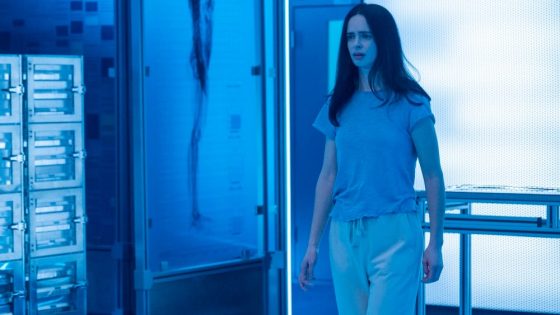SPOILER ALERT: This post contains spoilers from the series premiere of “Orphan Black: Echoes,” now streaming on AMC+.
The series premiere of AMC and BBC America’s “Orphan Black: Echoes” offers only a few concrete things about Lucy, the enigmatic character played by Krysten Ritter.
First and foremost, she’s innately resourceful, which comes in handy when she wakes up with no memory of who she is, with a kind but mysterious woman (Keeley Hawes) interrogating her about anything she might know. After a violent reaction, she MacGyvers her way out of the containment facility where she’s being held and right past a few clues that suggest her origins may lie in a slimy vat of goo. But before Lucy can investigate, she goes like a thief in the night, popping up two years later as a field-hand living the quiet life in the country.
She rents a mobile home on the land farm of a single father named Jack (Avan Jogia), with whom she shares a deeply loving relationship that they keep secret from his deaf daughter, Charlie (Zariella Langford-Haughton). We learn Lucy has a gun close by at all times, and has a pathological habit of avoiding any talk of her past — she also loves SpaghettiOs straight from the can. That’s about all we get, until things go south fast.
“I thought this was such an interesting acting challenge to take on a role that has no backstory, and no memories,” Ritter tells Variety. “She doesn’t feel the way she is supposed to feel, she doesn’t know who she is and she is completely on the run.”
That last part is made abundantly clear when a man arrives at her trailer and tries to subdue her. Lucy is more than capable of handling herself, it appears, but it’s a gunshot that saves her. Behind the trigger is Charlie, who came to her rescue with that gun Lucy needs to hide better.
With blood on both of their hands, Lucy makes them all leave town to stay one step ahead of the people who found her. While in Boston on the hunt for whoever is tracking her, she bumps into a teenage girl who looks strikingly like the one she keeps seeing in flashes of memories. But when they are confronted by yet another trigger-happy person, Lucy takes the girl hostage to go find answers.
Keeley Hawes
Courtesy of Sophie Giraud/AMC
Simultaneous to all of this, we see a few glimpses inside the Addictive Foundation, a medical technology organization that prints working replicas of vital organs. Run by Hawes’ unnamed woman from the opening sequence, the foundation is the one tracking Lucy, who was copied from DNA that did not have enough detail for memory recall. In other words, she’s a defect in their program and she’s a liability. In the final scene, the woman reveals herself to be Kira Manning, the daughter of Sarah Manning, one of the many clones played by Emmy winner Tatiana Maslany in BBC America’s original “Orphan Black” series.
With confirmation this is a sequel series set 30 years after the original, Ritter spoke to Variety about why she likes playing “an experiment gone wrong” and what it is like to act in the aforementioned vat of goo.
Beyond Lucy’s child-like dietary choices, how did you capture her tone and identity at the beginning of this show? Because of the nature of the story, your understanding of the character has to be malleable enough to evolve as she learns more about herself.
I thought this was such an interesting acting challenge, to take on a role that has no backstory and no memories. She doesn’t feel the way she is supposed to feel, she doesn’t know who she is and she is completely on the run. That was something I had never done before, and it is also something you don’t see very often. That was appealing to me. I kind of always envisioned her as a live wire with big feelings she doesn’t know what to do with. That was always my touchstone to come back to. There’s a lot going on with her, but she doesn’t know where to really put it and channel it.
In the opening moments of the premiere, we see just how instinctively smart she is when she breaks out of this containment housing. She goes straight for the light fixture and manages to break out by getting her arm inside the wall and opening the dead bolt. It was very impressive.
She tries every way to get out of that room. The glass won’t shatter, but she sees a sliver of light in the light switch. She recognizes the flaw in the design. She’s very smart.
“The flaw in the design” is an apt turn of phrase for this story, because Lucy is considered a defect in this program. Now, much of the episode is spent two years after her escape. Will we get to see what happened in those two years, and how her escape led to these comments made about drug abuse and homelessness?
We will get to see a bit of that, and understand what the last two years have been like for her in her relationship with Craig [Jonathan Whittaker] at the halfway house, and her relationship and love for Jack and Charlie. We will understand why she is trying to protect them, sort of at all costs. She is protecting her family unit that she has created for herself, because she has no one else and she loves them. When she realizes these people are after her, if she was on her own, she would keep running. But to protect them, she understands that she has to go figure out why they are after her, and get them to stop.
The thing with Lucy is that she is an experiment gone wrong. But because of the skills she has in her DNA and where it comes from, which we will explore, that would make her a threat of going rogue and being dangerous. I thought it was really interesting to play an experiment gone wrong. She doesn’t have the memory; she doesn’t have the feelings. She is just out in the world by herself. There is this constant conversation of nature versus nurture in this. How deep does love go at a cellular level?

Krysten Ritter as Lucy and Zariella Langford as Charlie.
Courtesy of Sophie Giraud/AMC
She certainly leans into the nurturing part of that equation in the premiere. She has built this relationship, secretive as it may be, with Jack and Charlie.
That was so appealing to me — I love that she has somebody to love. As a mother myself, I loved that I got to play that mother-daughter relationship between Lucy and Charlie, who she definitely sees as a stepdaughter. That dynamic is something that I definitely understood.
The final shot of the premiere confirms this is a true sequel series to “Orphan Black.” Was that daunting at all to be leading the next chapter of a pretty beloved series?
I appreciate that this came with a built-in audience. Frankly, it’s hard to launch a show anymore. There’s so many platforms and there are so many shows, and it is a lot of spinoffs and existing IP. So having that marquee name and a franchise show I thought was smart and great, but I really responded to it how it is its own thing. We are not redoing the original. It is not the same structure. I am not going to be playing eight versions of the same person like Tatiana Maslany did.
It is very different, and that was absolutely key for me in coming on. I mean, I am not trying to redo what she already did so beautifully. This is a completely different thing.
The original series really leaned into this idea of found family, but there was also the constant moral conversation of whether this cloning should have been done at all. It’s hard not to wonder why people haven’t learned their lesson in the 30 years since the original series –– especially Kira, who saw it firsthand with her mother.
I think that’s very important, and this series absolutely poses the question: Is this something we should be doing? Is this fair to be printing people out of nowhere, and then sending them out into the world?
But once Lucy finds the younger version and the older version, they do develop a kinship and a friendship and a connection based on their shared lack of history. And what’s fun is we get to watch them find the similarities in each other. That’s really exciting to play.
We get a glimpse at what is, for all intents and purposes, Lucy’s birthing process in this episode. What was it like to film that scene?
Oh right, the goo! It was a very technical experience and a lot of movie magic. The goo, I think, was all made of glucose. It was so heavy. Oh, and you floated in it! No kidding, they had to build a 70-pound belt to go across my waist just to keep me down. Otherwise, you just float up because there is no gravity there. It is wild! Very sticky, very thick. Then they built me a shower just off set where I could go rinse off — which was impossible. It took four or five people just to help me get there, because of how slippery it was. I love doing that stuff though. It is so fun, but a lot goes into making that beautiful photographic moment coming out of the goo.
Well, you all made it look very cool and sleek. Though no one would blame you if you panicked a little with that encasing over your face underwater. Talk about claustrophobic!
Yeah, being under there with that thing over my face, it’s like, “Hurry up and call action.” But that helps inform the choices I make and the performance to make it look authentic. So I’m kind of always up for a little bit of discomfort and a little struggle like that, because it just helps make it real.
Do you actually like SpaghettiOs?
I do not! They are disgusting. I have not had SpaghettiOs since I was a child. But they tasted like they had been in that can since I was a child, and they were disgusting. So no, not a fan!
This interview has been edited and condensed.
Source Agencies


